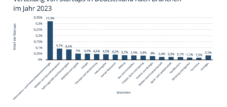Innovative transformation strategies: The path from SME to start-up and back
Language selection 📢
Published on: September 12, 2024 / update from: September 23, 2024 - Author: Konrad Wolfenstein
💡🚀 Stay flexible: SMEs balancing act between tradition and innovation
😊🚀 In the rapidly changing business world, small and medium-sized enterprises (SMEs) are faced with the challenge of keeping up with the dynamism and innovative power of startups. This balancing act between tradition and innovation requires creative solutions that enable SMEs to benefit from the advantages of both worlds. A particularly promising approach is to temporarily outsource parts of the company's development and cultivate them in a startup-like environment in order to later integrate them back into the parent company. This strategy offers SMEs the opportunity to increase their ability to innovate without having to completely abandon their tried and tested structures.
🌟 The Startup Mentality: A Key to Innovation
Startups are characterized by a number of distinctive characteristics that give them a decisive advantage in the modern economic landscape. These properties include:
- Flat hierarchies
- Willingness to innovate
- flexibility
- Speed in decision-making processes
These attributes enable startups to react agilely to market changes and quickly implement new ideas. It is often difficult for established SMEs to integrate these characteristics into their existing structures without jeopardizing the stability and efficiency that they have built up over the years.
🏔️ The challenges for SMEs
Medium-sized companies are often confronted with the following obstacles when it comes to implementing startup-like innovation processes:
- Evolved hierarchies and decision-making processes
- Established corporate culture that is skeptical about change
- Focus on existing products and services
- Risk aversion due to greater financial responsibility
These factors can significantly limit the ability of SMEs to innovate and adapt. Nevertheless, it is essential for these companies to find innovative solutions in order to survive in the increasingly competitive market environment.
🧠 The tricky solution approach: External innovation with internal integration
A promising strategy for SMEs is to outsource part of their development activities to a separate, startup-like environment. This approach makes it possible to reap the benefits of the startup mentality without jeopardizing the core business. The basic idea can be divided into the following steps:
1. Identification of innovation potential
The SME analyzes its business areas and identifies areas with a high need for innovation.
2. Spinning out into a startup environment
A separate team is formed for selected projects or business areas that operates outside of the existing corporate structures.
3. Cultivating the startup mentality
The outsourced team works with flat hierarchies, agile methods and a focus on fast innovation cycles.
4. Development and testing
New ideas, products or services are developed and tested in this protected space.
5. Reintegration
Successful innovations are gradually reintegrated into the parent company.
⚖️ Advantages of this strategy
This approach offers SMEs several key advantages:
1. Risk reduction
The spin-off minimizes the financial and operational risk for the core business.
2. Promoting innovation
The startup environment makes it possible to develop creative ideas without the restrictions of established structures.
3. Cultural change
The experiences from the startup sector can contribute to a cultural change throughout the company in the long term.
4. Talent acquisition
Innovative projects in a startup-like environment can attract highly qualified professionals who might not otherwise work for a traditional SME.
5. Market expansion
New products or services developed in this environment can lead to the development of new markets.
🔍 Challenges in implementation
Despite the promising prospects, implementing this approach presents some challenges:
1. Resource allocation
It must be carefully considered which human and financial resources can be made available for the outsourced project without affecting the core business.
2. Cultural differences
The different work cultures between the startup area and the parent company can lead to tensions.
3. Knowledge transfer
An effective knowledge sharing mechanism needs to be established between the outsourced team and the core company.
4. Reintegration
The reincorporation of successful innovations into the parent company can encounter resistance and must be carefully managed.
🧩 Best practices for successful implementation
To overcome the challenges mentioned and get the maximum benefit from this strategy, SMEs should consider the following best practices:
1. Clear objectives
Define precise goals for the outsourced project and communicate them transparently throughout the company.
2. Grant autonomy
Give the startup team the freedom they need to work creatively and innovatively without constant interference from the parent company.
3. Regular exchange
Establish structured communication channels between the outsourced team and relevant departments in the core company.
4. Mentoring program
Experienced managers from the SME can act as mentors for the startup team to promote knowledge transfer and networking.
5. Agile methods
Not only implement agile working methods in the outsourced area, but also gradually promote them in the parent company.
6. Measurement of success
Develop clear KPIs to measure and communicate the progress and success of the outsourced project.
7. Build cultural bridges
Organize regular joint events and workshops to promote cultural exchange between the startup team and the parent company.
📈 Case studies: Successful implementations in practice
Numerous companies have already successfully implemented similar strategies. A notable example is the German medium-sized company Bosch, which has created an internal incubator with its subsidiary Robert Bosch Start-up GmbH. This enables employees to develop innovative ideas in a startup-like environment. Successful projects are then reintegrated into the main company or continued as independent business units.
Another example is the medium -sized company Trumpf, a leading provider of machine tools. With his “internal team” initiative, Trumpf has created an internal accelerator who gives employees the opportunity to develop and implement their own business ideas. This initiative has already led to several successful outputs that complement and expand the core business of Trumpf.
🏢 Long-term impact on company culture
Implementing such an innovation strategy can have far-reaching positive effects on the entire company culture. Through contact with the startup mentality and agile working methods, employees in the main company are also inspired to think more innovatively and flexibly. This can lead to a gradual transformation of the corporate culture, making the entire SME more agile and innovative.
In addition, this approach can help increase the company's attractiveness as an employer. Young, talented professionals who would normally gravitate towards startups can be attracted by the combination of the stability of an established company and the dynamism of a startup environment.
🔄 Future prospects: The hybrid organization
In the long term, this approach could lead to a new form of business organization - the hybrid organization. In this model, a company combines the stability and resource strength of an established SME with the agility and innovative strength of a startup.
These hybrid organizations are characterized by the following characteristics:
1. Flexible structures
The company structure adapts dynamically to the requirements of the market and the respective projects.
2. Continuous innovation
Innovation is not seen as a one-off project, but as an ongoing process and is lived in all areas of the company.
3. Ambidexterity
The ability to simultaneously optimize the existing business and explore new business areas.
4. Cultural diversity
A corporate culture that values stability and efficiency as well as creativity and willingness to take risks.
5. Lifelong learning
A strong focus on continuous training and development of employees.
📅 A promising path into the future
The approach of outsourcing parts of the company's development to a startup-like environment and later reintegrating it offers SMEs a promising opportunity to increase their ability to innovate without having to completely abandon their tried and tested structures. This strategy makes it possible to combine the advantages of both worlds - the stability and resource strength of an established company and the agility, creativity and willingness to take risks of a startup. This approach not only enables SMEs to develop and test new technologies and business models more quickly, but also foster a more dynamic corporate culture that encourages innovation. In addition, this strategy opens up opportunities for closer collaboration with startups and technology partners, increasing knowledge exchange and co-innovation between established companies and young, innovative players in the market. This allows SMEs to respond more effectively to market requirements and ensure their competitiveness in a rapidly changing economic landscape.
📣 Similar topics
- 🚀 Innovative SME strategies for transformation
- 🏢 Preserve tradition, promote innovation
- 🌟 Startup mentality for SME success
- 🔄 External innovation, internal integration
- 💪 Overcoming challenges for SMEs
- 🌐 Cultural change through startup experiences
- 💡 Risk minimization through startup outsourcing
- 📊 Best practices for SME transformation
- 🏆 Successful case studies from practice
- 📈 Hybrid organizations as a future model
#️⃣ Hashtags: # SME # Innovation # Startups # Corporate Development # Cultural Change
We are there for you - advice - planning - implementation - project management
☑️ Start-up and industry expert, here with its own Xpert.Digital industry hub with over 2,500 specialist articles
I would be happy to serve as your personal advisor.
You can contact me by filling out the contact form below or simply call me on +49 89 89 674 804 (Munich) .
I'm looking forward to our joint project.
Xpert.Digital - Konrad Wolfenstein
Xpert.Digital is a hub for industry with a focus on digitalization, mechanical engineering, logistics/intralogistics and photovoltaics.
With our 360° business development solution, we support well-known companies from new business to after sales.
Market intelligence, smarketing, marketing automation, content development, PR, mail campaigns, personalized social media and lead nurturing are part of our digital tools.
You can find out more at: www.xpert.digital - www.xpert.solar - www.xpert.plus






























